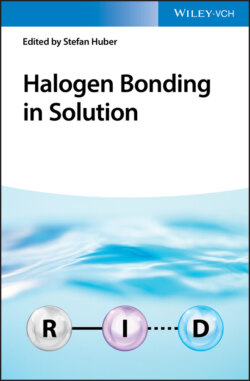Читать книгу Halogen Bonding in Solution - Группа авторов - Страница 9
Preface
ОглавлениеHalogen bonding has been “known” since the onset of modern chemistry, and thus for about as long as hydrogen bonding, even though a clear structural and theoretical understanding was first developed much later. But while hydrogen bonding has been studied intensively in the past and has obviously been an integral part of countless applications in all fields of chemistry, halogen bonding has remained some sort of curiosity for a long time. Even after it had received increased interest in crystal engineering and theory from the 1990s on, solution‐phase applications have been essentially absent until 10–15 years ago. Since then, however, inspired by many successful solid‐state studies, the use of halogen bonding in solution has thrived quite remarkably, and interesting studies appear at ever‐increasing frequency. Thus, it seems timely to provide an overview on this matter, which is the aim of this book.
I am very happy that we could recruit the perfect lineup of authors for this task, as all groups involved are renowned for their expertise in the respective field and are considered pioneers on the respective topic.
The introduction by Berryman and coworkers is intended to get readers – particularly those not very familiar with the topic – up to speed on the general features of halogen bonding and the latest developments in crystal engineering, which is arguably still its core field of application. For a rational design of strong halogen bond donors, a clear understanding of their binding to various substrates is essential, and so the next four chapters focus on various halogen bonding motifs, the recognition of substrates, and the associated thermodynamics. Taylor first discusses the interaction of structurally diverse “small molecule” halogen bond donors with Lewis bases and analyzes the underlying thermodynamic trends to provide a basis for the further applications described in later chapters. Subsequently, Beer discusses structurally complex halogenated Lewis acids, especially macrocycles and interlocked systems. The latter, in particular, are a vivid demonstration of the level of sophistication that has already been achieved with halogen bonding in solution. While all these halogen bond donors are based on terminal halogen substituents, strong halogen bonds can also be formed in NXN systems, in which X+ may be considered as the key electrophile, as discussed by Erdelyi in the following chapter. The same author has then teamed up with Herrebout to describe in more detail the currently available techniques to spectroscopically study halogen bonding in solution. Nuclear magnetic resonance (NMR) spectroscopy, most of all, allows a wealth of information to be extracted on the nature of halogen‐bonded complexes.
The subsequent four chapters deal with more specific applications of halogen bonding extending pure binding and recognition in several different directions. Vargas‐Jentzsch and Matile illustrate how the binding of anions can be used for transport processes and how just the right strength of halogen bonding is crucial for optimal performance. The two ensuing chapters focus on the use of halogen bonding in catalysis, with Breugst et al. discussing applications of elemental iodine in organic reactions. While iodine has been known as a potent catalyst for some time, in most cases, its exact mode of action has remained unknown until very recently. A disadvantage of elemental iodine is the fact that it is not very susceptible to modification, and so Sutar subsequently discusses the use of more complex organic (and sometimes inorganic) halogenated compounds in organocatalysis. Finally, Schöllhorn and Fave describe how electrochemistry can be used to severely alter the halogen bonding strength of halogenated Lewis acids and to detect the formation of adducts.
Halogen bonding has also received much attention in biological context. Here, the focus is typically on the specific modification of DNA or peptide motifs to elucidate the influences of halogen bonding on structure and activity. These topics are discussed in detail by Ho in the last chapter on halogen bonding.
Inspired by halogen bonding, investigations on related interactions involving elements of groups VI/16 (chalcogen bonding), V/15 (pnictogen bonding), and even IV/14 (tetrel bonding) have intensified in the last years. Surely, the most studied of these so far is chalcogen bonding. Thus, we close the book with an overview on this topic by Mahmudov and Pombeiro, which provides a comparison with halogen bonding and a perspective on the further development of studies on noncovalent interactions.
As reflected by this overview, this book clearly focuses on experimental findings, and theoretical modeling of solvent effects is only mentioned in passing. There is, however, a definite need for further studies in this regard: in contrast to hydrogen bonding, the solvent dependency of halogen bonding currently seems to be barely studied and accordingly is an unresolved issue.
This book is intended for a variety of readers. It was written with nonexperts (including teachers in higher education) in mind, and hence those entirely unfamiliar with the topic will naturally take away most from it. However, even researchers who are active in the field will find valuable information on topics that are further from their core interest.
Finally, I would like to thank the team at Wiley for all their support: Shirly Samuel, Elke Maase, Katherine Wong, and in particular Anne Brennführer, who initiated this project. I thank the authors for providing such rich chapters despite their full schedules, and I also thank various members of my group (who shall remain anonymous to protect them from angry authors… ;‐)) for their help with proofreading.
I hope that you will enjoy this journey into various aspects of halogen bonding in solution and that you will concurrently become as fascinated by this topic as all of the authors already are.
March 2020
Stefan Huber
Bochum
